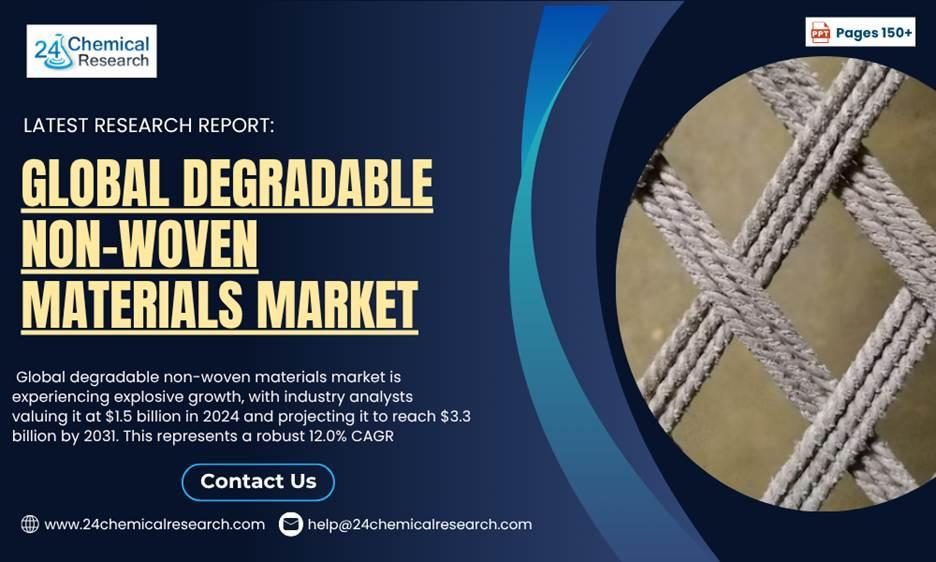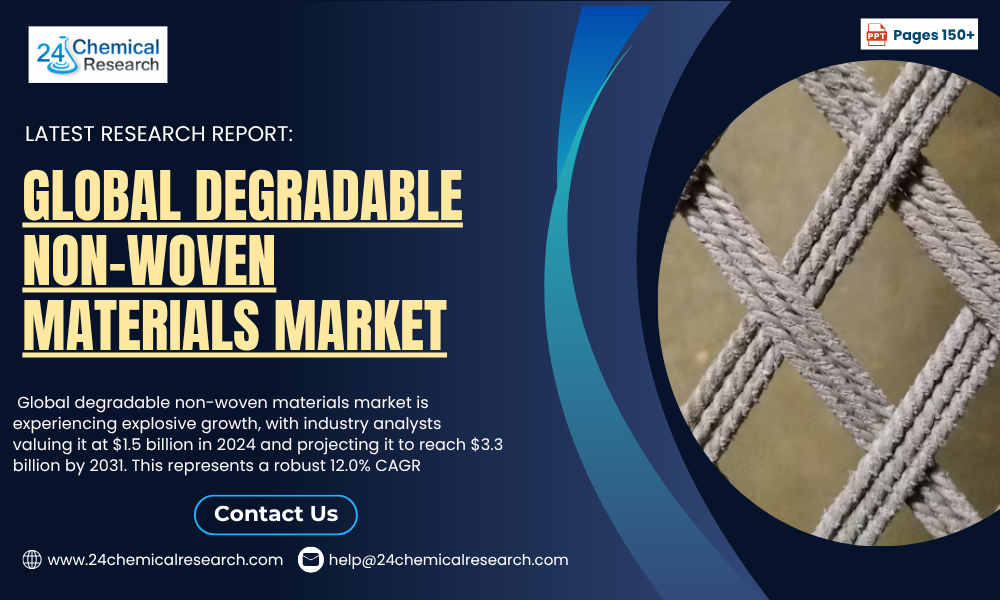Global degradable non-woven materials market is experiencing explosive growth, with industry analysts valuing it at $1.5 billion in 2024 and projecting it to reach $3.3 billion by 2031. This represents a robust 12.0% CAGR as demand surges across multiple industries seeking sustainable alternatives to traditional materials. The market's expansion is being fueled by regulatory pressures and shifting consumer preferences toward eco-friendly solutions.
Degradable non-wovens have become indispensable in applications ranging from medical textiles to geotextiles, offering unique advantages like breathability and moisture resistance while addressing environmental concerns. As circular economy initiatives gain traction globally, manufacturers are increasingly investing in bio-based material research and advanced production technologies.
Download FREE Sample Report: https://www.24chemicalresearch.com/admin24cr/download-sample/290610/global-degradable-nonwoven-materials-forecast-market-2025-2031-862
Industry Landscape and Regional Market Trends
North America currently dominates with approximately 35% market share, thanks to stringent environmental regulations and advanced recycling infrastructure. The region's healthcare sector particularly drives demand for medical-grade degradable non-wovens, while construction applications are seeing increased adoption of geotextiles.
Europe follows closely with 30% market penetration, where EU directives on single-use plastics have accelerated innovation. Meanwhile, Asia-Pacific is emerging as the fastest-growing region, with government initiatives in countries like China and India promoting sustainable materials. While infrastructure challenges persist in Latin America and Africa, both regions demonstrate untapped potential as sustainability awareness grows.
Market Segmentation Analysis:
Market Segmentation by Type
- Spunlaced Nonwovens
- Melt-blown Nonwovens
- Spunbond Nonwovens
- Needle-punched Nonwovens
- Other Specialty Nonwovens
Market Segmentation by Application
- Medical Care (surgical drapes, wound dressings, masks)
- Civil Engineering (geotextiles, erosion control)
- Industrial Filtration
- Household Products (wipes, cleaning cloths)
- Packaging Solutions
- Other Specialty Applications
Competitive Landscape and Key Players
The market features a mix of global chemical giants and specialized manufacturers:
- UNITIKA (Japan)
- Asahi Kasei (Japan)
- Sateri (China)
- WPT Nonwovens (USA)
- IHSAN Sons (Pakistan)
- Xinlong Holding Group (China)
- Xiamen Yanjan New Material (China)
Future Outlook & Strategic Recommendations
The degradable non-woven materials market is expected to witness accelerated growth in the coming years as global sustainability initiatives intensify and industries seek eco-friendly alternatives to conventional textiles. Innovations in bio-based polymers and advanced fiber bonding technologies are anticipated to enhance product performance, enabling their adoption in high-value applications such as surgical textiles, erosion control, and industrial filtration. Asia-Pacific is poised to lead future demand growth, supported by government incentives for biodegradable materials and expanding manufacturing capacities in China and India. To fully leverage this momentum, companies should prioritize R&D investments in high-strength and antimicrobial degradable non-wovens, expand partnerships within healthcare and packaging sectors, and diversify raw material sourcing to mitigate supply chain risks. Furthermore, aligning with evolving global certification standards and promoting transparent environmental credentials will be critical in capturing premium markets and sustaining long-term competitive advantage.
Key Market Drivers and Emerging Opportunities
The market is being propelled by multiple factors including:
- Global plastic waste reduction initiatives and single-use plastic bans
- Healthcare sector's shift toward sustainable medical textiles
- Construction industry's adoption of eco-friendly geotextiles
- Packaging sector's transition to biodegradable solutions
- Technological advancements in material engineering
Exciting opportunities lie in the development of next-generation materials with enhanced functionality, such as antimicrobial properties for medical applications and higher tensile strength for industrial uses. The growing popularity of organic personal care products also presents new avenues for biodegradable non-woven applications.
Industry Challenges and Restraints
Despite strong growth prospects, the market faces several hurdles:
- Higher production costs compared to conventional synthetic non-wovens
- Limited availability of specialized manufacturing equipment
- Variability in degradation rates under different environmental conditions
- Lack of standardized testing and certification protocols
- Competition from alternative sustainable materials
Balancing performance characteristics with environmental benefits remains an ongoing challenge for manufacturers, particularly in cost-sensitive applications where price premiums for sustainable materials are difficult to justify.
These industry leaders are engaged in strategic initiatives including capacity expansions, technological collaborations, and sustainable product development to maintain their competitive edge in this rapidly evolving market.
Report Scope and Methodology
This comprehensive analysis provides detailed insights into:
- Current market size and growth projections through 2031
- In-depth regional market assessments
- Technology and material innovations
- Regulatory landscape and impact analysis
- Competitive benchmarking and company profiles
- Emerging application opportunities
The research methodology combines primary interviews with industry experts, comprehensive secondary research, and proprietary data analysis to deliver actionable market intelligence.
Get Full Report Here: https://www.24chemicalresearch.com/admin24cr/reports/290610/global-degradable-nonwoven-materials-forecast-market-2025-2031-862
Access more Related report-
Architectural Paints Market Size,Demand & Supply, Regional and Competitive Analysis 2024-2031
Frequently Asked Questions
Q: What are the key advantages of degradable non-woven materials?
A: These materials offer the functionality of traditional non-wovens while providing environmental benefits such as reduced landfill waste and lower carbon footprint through biodegradability.
Q: Which industries are driving demand growth?
A: Healthcare, packaging, and construction sectors are currently the primary demand drivers, though applications in agriculture and filtration are growing rapidly.
Q: How do regional regulations impact market development?
A: Regions with stringent environmental policies (EU, North America) are seeing faster adoption, while emerging markets are following as local regulations evolve.
Q: What technological advancements are shaping the industry?
A: Innovations include improved fiber bonding techniques, enhanced material durability, and the development of new bio-based polymer formulations.
Q: How does pricing compare to conventional alternatives?
A: While currently priced at a premium, economies of scale and technological improvements are gradually reducing the cost differential with traditional materials.
Contact Us:
Email: help@24chemicalresearch.com
International: +1(332) 2424 294 | Asia: +91 9169162030
Website: https://www.24chemicalresearch.com/



